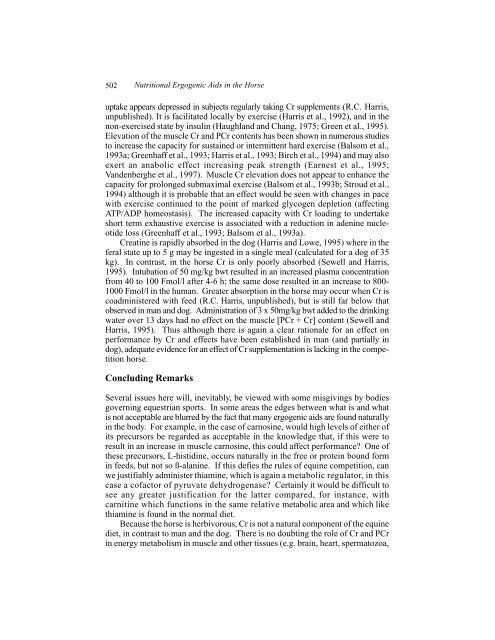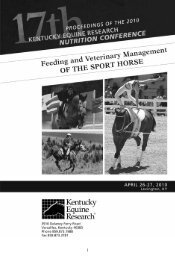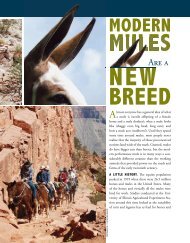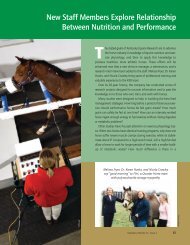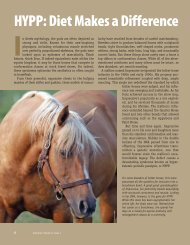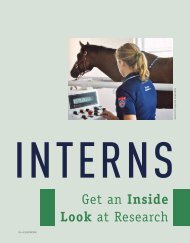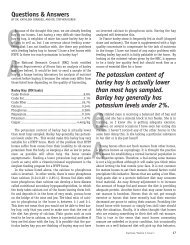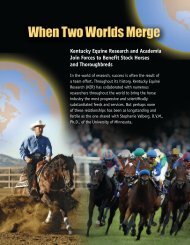Nutritional Ergogenic Aids in the Horse - Kentucky Equine Research
Nutritional Ergogenic Aids in the Horse - Kentucky Equine Research
Nutritional Ergogenic Aids in the Horse - Kentucky Equine Research
- No tags were found...
You also want an ePaper? Increase the reach of your titles
YUMPU automatically turns print PDFs into web optimized ePapers that Google loves.
502 <strong>Nutritional</strong> <strong>Ergogenic</strong> <strong>Aids</strong> <strong>in</strong> <strong>the</strong> <strong>Horse</strong>uptake appears depressed <strong>in</strong> subjects regularly tak<strong>in</strong>g Cr supplements (R.C. Harris,unpublished). It is facilitated locally by exercise (Harris et al., 1992), and <strong>in</strong> <strong>the</strong>non-exercised state by <strong>in</strong>sul<strong>in</strong> (Haughland and Chang, 1975; Green et al., 1995).Elevation of <strong>the</strong> muscle Cr and PCr contents has been shown <strong>in</strong> numerous studiesto <strong>in</strong>crease <strong>the</strong> capacity for susta<strong>in</strong>ed or <strong>in</strong>termittent hard exercise (Balsom et al.,1993a; Greenhaff et al., 1993; Harris et al., 1993; Birch et al., 1994) and may alsoexert an anabolic effect <strong>in</strong>creas<strong>in</strong>g peak strength (Earnest et al., 1995;Vandenberghe et al., 1997). Muscle Cr elevation does not appear to enhance <strong>the</strong>capacity for prolonged submaximal exercise (Balsom et al., 1993b; Stroud et al.,1994) although it is probable that an effect would be seen with changes <strong>in</strong> pacewith exercise cont<strong>in</strong>ued to <strong>the</strong> po<strong>in</strong>t of marked glycogen depletion (affect<strong>in</strong>gATP/ADP homeostasis). The <strong>in</strong>creased capacity with Cr load<strong>in</strong>g to undertakeshort term exhaustive exercise is associated with a reduction <strong>in</strong> aden<strong>in</strong>e nucleotideloss (Greenhaff et al., 1993; Balsom et al., 1993a).Creat<strong>in</strong>e is rapidly absorbed <strong>in</strong> <strong>the</strong> dog (Harris and Lowe, 1995) where <strong>in</strong> <strong>the</strong>feral state up to 5 g may be <strong>in</strong>gested <strong>in</strong> a s<strong>in</strong>gle meal (calculated for a dog of 35kg). In contrast, <strong>in</strong> <strong>the</strong> horse Cr is only poorly absorbed (Sewell and Harris,1995). Intubation of 50 mg/kg bwt resulted <strong>in</strong> an <strong>in</strong>creased plasma concentrationfrom 40 to 100 Fmol/l after 4-6 h; <strong>the</strong> same dose resulted <strong>in</strong> an <strong>in</strong>crease to 800-1000 Fmol/l <strong>in</strong> <strong>the</strong> human. Greater absorption <strong>in</strong> <strong>the</strong> horse may occur when Cr iscoadm<strong>in</strong>istered with feed (R.C. Harris, unpublished), but is still far below thatobserved <strong>in</strong> man and dog. Adm<strong>in</strong>istration of 3 x 50mg/kg bwt added to <strong>the</strong> dr<strong>in</strong>k<strong>in</strong>gwater over 13 days had no effect on <strong>the</strong> muscle [PCr + Cr] content (Sewell andHarris, 1995). Thus although <strong>the</strong>re is aga<strong>in</strong> a clear rationale for an effect onperformance by Cr and effects have been established <strong>in</strong> man (and partially <strong>in</strong>dog), adequate evidence for an effect of Cr supplementation is lack<strong>in</strong>g <strong>in</strong> <strong>the</strong> competitionhorse.Conclud<strong>in</strong>g RemarksSeveral issues here will, <strong>in</strong>evitably, be viewed with some misgiv<strong>in</strong>gs by bodiesgovern<strong>in</strong>g equestrian sports. In some areas <strong>the</strong> edges between what is and whatis not acceptable are blurred by <strong>the</strong> fact that many ergogenic aids are found naturally<strong>in</strong> <strong>the</strong> body. For example, <strong>in</strong> <strong>the</strong> case of carnos<strong>in</strong>e, would high levels of ei<strong>the</strong>r ofits precursors be regarded as acceptable <strong>in</strong> <strong>the</strong> knowledge that, if this were toresult <strong>in</strong> an <strong>in</strong>crease <strong>in</strong> muscle carnos<strong>in</strong>e, this could affect performance? One of<strong>the</strong>se precursors, L-histid<strong>in</strong>e, occurs naturally <strong>in</strong> <strong>the</strong> free or prote<strong>in</strong> bound form<strong>in</strong> feeds, but not so ß-alan<strong>in</strong>e. If this defies <strong>the</strong> rules of equ<strong>in</strong>e competition, canwe justifiably adm<strong>in</strong>ister thiam<strong>in</strong>e, which is aga<strong>in</strong> a metabolic regulator, <strong>in</strong> thiscase a cofactor of pyruvate dehydrogenase? Certa<strong>in</strong>ly it would be difficult tosee any greater justification for <strong>the</strong> latter compared, for <strong>in</strong>stance, withcarnit<strong>in</strong>e which functions <strong>in</strong> <strong>the</strong> same relative metabolic area and which likethiam<strong>in</strong>e is found <strong>in</strong> <strong>the</strong> normal diet.Because <strong>the</strong> horse is herbivorous, Cr is not a natural component of <strong>the</strong> equ<strong>in</strong>ediet, <strong>in</strong> contrast to man and <strong>the</strong> dog. There is no doubt<strong>in</strong>g <strong>the</strong> role of Cr and PCr<strong>in</strong> energy metabolism <strong>in</strong> muscle and o<strong>the</strong>r tissues (e.g. bra<strong>in</strong>, heart, spermatozoa,


